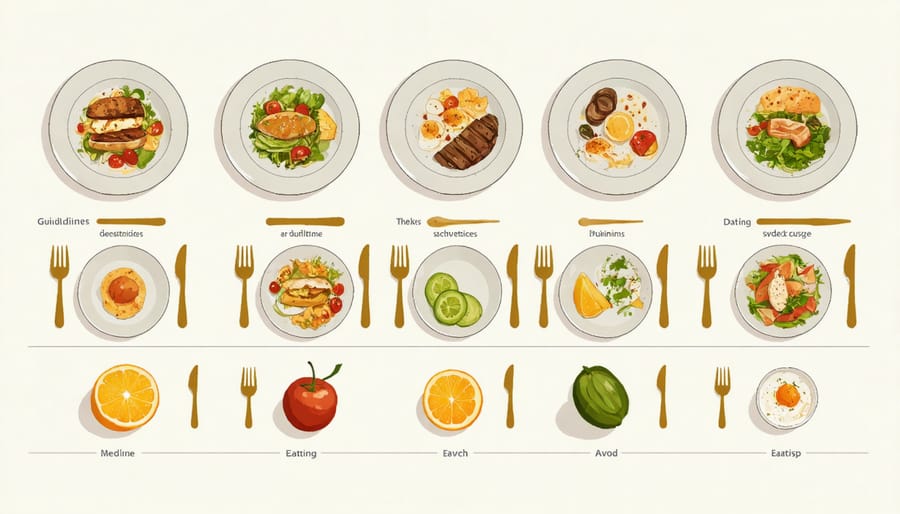
Transform your relationship with food through mindful eating practices that nurture both body and soul. In our fast-paced world, where meals often become an afterthought, these 12 proven strategies will help you rediscover the joy and intention behind every bite. Whether you’re struggling with emotional eating, seeking better portion control, or simply wanting to cultivate a more conscious approach to nourishment, this comprehensive guide provides practical, easy-to-implement techniques that fit seamlessly into your daily routine.
Drawing from both ancient wisdom and modern nutritional science, these mindful eating strategies offer a balanced approach that goes beyond traditional diet rules. You’ll learn to recognize genuine hunger signals, savor each meal with presence, and develop a deeper understanding of your body’s unique needs. Perfect for busy women juggling career, family, and self-care, these techniques can be practiced anywhere, anytime – turning every meal into an opportunity for mindfulness and self-discovery.
Let’s explore these transformative strategies that will not only change how you eat but also how you experience and appreciate food in your daily life.
Creating Your Perfect Mindful Eating Environment

Setting the Stage for Success
Creating a peaceful eating environment is just as important as what’s on your plate. Start by designating a specific eating area in your home – somewhere away from screens and distractions. I love setting my table with a simple centerpiece and using real plates instead of eating from containers, which instantly elevates the experience.
Dim the harsh overhead lights and opt for softer lighting if possible. Consider playing gentle background music at a low volume – I’ve found that instrumental jazz works wonderfully. Keep your eating space clutter-free and organized, as a messy environment can lead to distracted eating.
Take a moment to arrange your food thoughtfully on your plate, making it visually appealing. Before each meal, take three deep breaths to transition into a calmer state of mind. Remember, your eating environment sets the tone for your entire meal experience, so make it count!
Eliminating Distractions
Creating a distraction-free eating environment is crucial for mindful eating success. Just like you wouldn’t scroll through social media during an important meeting, your meals deserve the same focused attention. Start by designating a specific eating area in your home – ideally at a table, not in front of the TV. Turn off your phone notifications or, better yet, keep your device in another room during mealtimes.
I’ve found that setting a beautiful table, even when eating alone, helps signal to your brain that this is dedicated eating time. Light a candle, use nice plates, and create a peaceful atmosphere. If you’re eating at work, step away from your desk and find a quiet spot to enjoy your meal. When dining with others, establish a no-phones policy and focus on meaningful conversation instead.
Remember, these moments of mindful eating are your time to nourish both body and soul – protect them like the precious occasions they are.
12 Practical Mindful Eating Strategies

Pre-Meal Rituals (Strategies 1-3)
Before you take that first bite, let’s explore three powerful pre-meal rituals that can help transform your relationship with food and set the stage for a more mindful eating experience.
1. The Three-Breath Reset
Take a moment to pause and connect with your body through three deep breaths. I love doing this simple practice because it helps shift my mind from the day’s chaos to the present moment. Inhale deeply through your nose, feeling your belly expand, and exhale slowly through your mouth. This ritual signals to your body that it’s time to transition into a more relaxed state, perfect for optimal digestion.
2. Gratitude Connection
Before diving into your meal, acknowledge where your food came from and express gratitude for it. Think about the farmers who grew the ingredients, the people who prepared the meal, and the nourishment it will provide your body. This practice might feel a bit awkward at first (trust me, I’ve been there!), but it becomes second nature with time and adds a beautiful layer of appreciation to your dining experience.
3. Environment Setup
Create a calm, inviting space for your meal. Turn off the TV, put your phone on silent (or better yet, in another room), and set your table thoughtfully. I’ve noticed that when I take just two minutes to clear my eating space and maybe light a candle, my meals become so much more enjoyable. If you’re eating alone, consider playing soft background music instead of automatically reaching for your phone for company.
Remember, these rituals don’t need to be elaborate or time-consuming. Even implementing one or two of them can make a significant difference in how you approach and enjoy your meals.
During-Meal Practices (Strategies 4-8)
Now that you’ve prepared mindfully for your meal, let’s explore the heart of mindful eating – what happens during the actual eating process. These five strategies will help you stay present and engaged while enjoying your food.
Strategy 4: The Pause and Appreciate Method
Before taking your first bite, take a moment to truly look at your food. Notice the colors, textures, and arrangement on your plate. I love doing this especially with colorful salads or home-cooked meals – it’s like taking a moment to appreciate a piece of art you’ve created or received.
Strategy 5: The 20-Chew Challenge
Try chewing each bite around 20 times before swallowing. This might sound like a lot (trust me, I thought so too!), but it’s a game-changer for both digestion and meal satisfaction. It helps you notice subtle flavors and textures you might have missed with hurried eating.
Strategy 6: Put Down Your Utensils
Between bites, place your fork or spoon down on the table. This simple act creates natural pauses in your meal and prevents the notorious “shoveling” effect we’ve all experienced during busy days. Think of it as pressing the pause button on your favorite show – it gives you time to process what’s happening.
Strategy 7: The Mindful Mid-Meal Check
Halfway through your meal, take a conscious break to assess your hunger level. Are you still hungry? Are you starting to feel satisfied? This practice helps prevent overeating and builds a stronger connection with your body’s natural hunger and fullness cues.
Strategy 8: Engage Your Senses Fully
Make it a point to notice at least three distinct flavors, textures, or aromas in each dish. Maybe it’s the crunch of fresh vegetables, the warmth of soup, or the aromatic herbs in your pasta. This practice turns every meal into a more engaging and satisfying experience.
Remember, these strategies aren’t about creating perfect eating habits overnight. They’re tools you can experiment with and adapt to your lifestyle. Some days you might use all of them, other days just one or two – and that’s perfectly okay. The key is to find what works best for you and makes eating a more conscious, enjoyable experience.

Post-Meal Reflection (Strategies 9-12)
Just as important as how we eat is how we conclude our meals and reflect on our eating experience. These final four strategies help you create meaningful post-meal practices that enhance your overall holistic wellness habits.
Strategy 9 focuses on the pause-and-reflect technique. Take a moment after finishing your meal to assess your satisfaction level. Are you comfortably full? Did you enjoy your food? This simple practice helps you better understand your body’s signals and strengthens your mind-body connection.
Strategy 10 encourages expressing gratitude for your meal. Whether it’s appreciation for the hands that prepared it, the farmers who grew the ingredients, or simply having access to nourishing food, this practice shifts your relationship with eating from mundane to meaningful. I love keeping a small gratitude journal in my kitchen where I jot down memorable meals and moments of food-related thankfulness.
Strategy 11 involves mindful cleanup. Instead of rushing to clear the table, transform post-meal cleanup into a meditative practice. As you wash dishes or pack leftovers, notice the lingering aromas, the sensation of warm water on your hands, and the satisfaction of creating order. This routine helps signal to your body that the meal is complete.
Strategy 12 introduces the concept of a mini digestive rest. Resist the urge to immediately jump into activities after eating. Take 5-10 minutes to sit quietly, perhaps sipping herbal tea or taking a gentle walk. This practice not only aids digestion but also helps you transition mindfully between meal time and your next activity.
Remember, these post-meal strategies aren’t about rigid rules – they’re invitations to create more conscious connections with your food and body. Many of my readers find that implementing even one or two of these practices has transformed their eating experience from rushed and mindless to peaceful and intentional. Start with what feels most natural to you, and gradually incorporate others as they resonate with your lifestyle.
Incorporating Mindful Eating into Your Daily Routine
Making mindful eating a regular part of your day doesn’t have to feel overwhelming. The key is to start small and gradually build habits that nourish your mind and body in sustainable ways. Begin by choosing just one meal a day to practice mindful eating – many find breakfast ideal since mornings tend to be less rushed.
Create a dedicated eating space in your home where you can sit comfortably without distractions. I’ve found that setting my table with nice placemats and keeping my phone in another room helps create a more intentional dining experience. Even if you’re eating alone, treat each meal as a special occasion worthy of your full attention.
Try setting a timer for 20 minutes during meals to remind yourself to eat slowly. This might feel strange at first (trust me, I’ve been there!), but it helps you recognize your body’s natural fullness signals. Between bites, put down your utensils and take a moment to appreciate the flavors and textures of your food.
Remember that mindful eating isn’t about perfection – it’s about presence. Some days, you might only manage a few mindful bites, and that’s perfectly okay. The goal is to gradually build awareness around your eating habits while being gentle with yourself in the process.
Consider keeping a mindful eating journal to track your progress and observations. Note how different foods make you feel, what triggers mindless eating, and celebrate the small wins along your journey. This personal record becomes an invaluable tool for understanding your unique relationship with food and maintaining long-term success.
Embarking on your mindful eating journey is a beautiful way to transform your relationship with food and nourish both body and soul. By implementing these twelve strategies – from creating a peaceful eating environment to practicing gratitude for your meals – you’ll discover a more conscious and fulfilling approach to eating. Remember, mindful eating isn’t about perfection; it’s about progress and self-discovery. Start small by choosing one or two strategies that resonate with you, and gradually incorporate others as they feel natural. Your journey to mindful eating is uniquely yours, and every small step counts toward creating lasting, healthy habits. As you begin this transformation, be patient and kind with yourself. The simple act of bringing awareness to your eating habits is already a significant achievement. Here’s to your wellness journey – may it bring you joy, health, and a deeper connection with yourself and your food choices.



